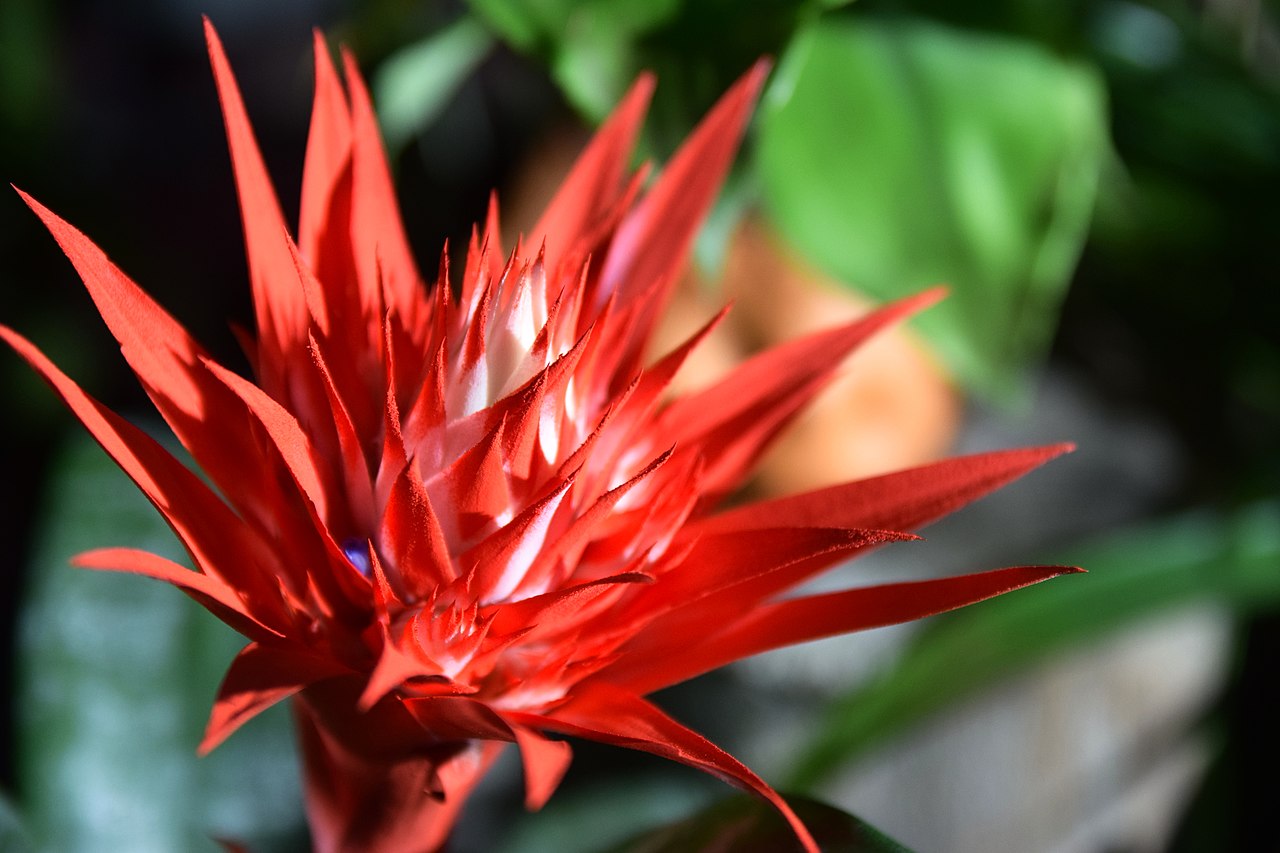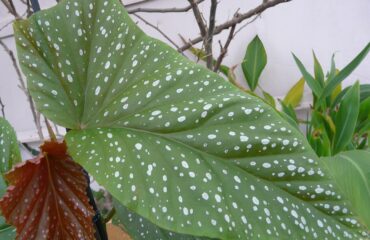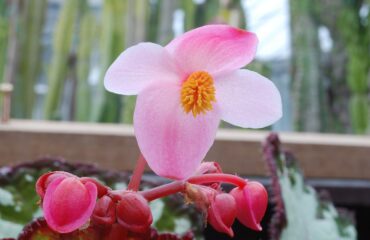Bromeliads are a diverse family of tropical plants known for their unique rosette-shaped foliage and striking flowers. Native to the Americas, Bromeliads come in a wide range of sizes, shapes, and colors, making them a popular choice for indoor and outdoor cultivation. The foliage varies from thick, leathery leaves to soft, arching ones, often displaying vibrant hues and intricate patterns. Bromeliads typically produce a single central flower spike, which can be brightly colored and long-lasting. They are epiphytic, meaning they often grow on other plants or surfaces, but they can also be grown in soil. Bromeliads are ideal for adding a touch of the exotic to homes, gardens, and greenhouses.
Preferred Growing Conditions:
- Soil Type: Prefers well-draining, airy soil; thrives in a mix designed for orchids or a combination of peat, pine bark, and perlite. Epiphytic varieties can be grown on bark or mounted on pieces of wood.
- Sunlight: Grows best in bright, indirect light; some varieties can tolerate low light, while others need more direct sun. Generally, more colorful Bromeliads need brighter light.
- Temperature: Hardy in USDA zones 10-11 as a perennial outdoors but commonly grown indoors in cooler climates; prefers temperatures between 60-80°F (15-27°C) and does not tolerate frost.
- Water Needs: Moderate; requires regular watering but prefers to dry out slightly between waterings. Most Bromeliads store water in their central cup, and it’s crucial to keep this filled. Ensure good air circulation to prevent water stagnation.
Bromeliads Propagation Methods:
1. Offsets (Pups):
Offsets, also known as pups, are the most common and effective method for propagating Bromeliads. Pups are the small plants that develop at the base of the parent plant.
- Types of Offsets:
- Use offsets that have grown to at least one-third the size of the parent plant and have developed a few roots.
- Preparation:
- Carefully remove the pup from the parent plant using a clean, sharp knife or scissors.
- Ensure that the offset has some roots attached to help establish the new plant.
- Planting:
- Plant the offset in a well-draining potting mix suitable for Bromeliads or orchids.
- Firmly press the soil around the base of the offset to ensure good contact with the roots.
- Water lightly to settle the soil and place the pot in a bright, indirect light location.
- Rooting:
- Roots should begin to establish within a few weeks.
- Keep the soil slightly moist but not waterlogged.
- Once the pup is well-rooted and begins to grow, gradually acclimate it to its new environment.
2. Seed Propagation:
Growing Bromeliads from seeds is possible but requires patience and precise care. This method allows for genetic diversity and the chance to cultivate unique plants.
- Seed Collection and Preparation:
- Collect seeds from mature flower spikes after they have dried and the seeds have matured.
- Clean and dry the seeds for a few days before planting or store them in a cool, dry place until ready to plant.
- Sowing Techniques:
- Sow seeds in a shallow tray filled with a well-draining seed-starting mix or a mixture of sphagnum moss and perlite.
- Scatter the seeds evenly on the surface and press them lightly into the soil without covering them.
- Mist the surface lightly and cover the tray with a clear plastic lid or plastic wrap to maintain high humidity.
- Place the tray in a bright, indirect light location with temperatures around 70-75°F (21-24°C).
- Germination Requirements:
- Seeds typically germinate within 2-4 weeks under optimal conditions.
- Once seedlings emerge, gradually remove the cover to provide better air circulation.
- Keep the soil slightly moist and provide bright, indirect light.
- Transplanting Seedlings:
- When seedlings have developed several true leaves and are sturdy enough to handle, transplant them into individual pots.
- Use a well-draining potting mix and maintain a humid environment to encourage growth.
3. Division:
Division is a method used primarily for terrestrial Bromeliads or those that form clumps. This method helps rejuvenate the parent plant and produce new plants with identical characteristics.
- Timing:
- The best time for division is in early spring before new growth begins or in early autumn after the active growing season.
- Method:
- Carefully remove the plant from its pot and gently separate the root ball into smaller sections, ensuring each division has several shoots and a portion of the root system.
- Use a sharp knife or garden spade to divide the root ball if necessary.
- Remove any dead or damaged roots and foliage.
- Replanting:
- Replant the divisions immediately in prepared pots filled with a well-draining potting mix.
- Plant at the same depth as the original clump, spacing divisions to allow room for growth.
- Water thoroughly to settle the soil around the roots.
- Care After Division:
- Keep the newly planted divisions well-watered as they establish.
- Place the pots in a bright, indirect light location.
- Maintain high humidity and protect from strong drafts and sudden temperature changes during the initial recovery period.
4. Tissue Culture:
Tissue culture is an advanced propagation method used primarily in commercial settings to produce large numbers of uniform plants quickly. This method involves growing plant tissues in a sterile, controlled environment.
- Process:
- Small pieces of plant tissue, typically from the growing tips or meristem, are sterilized and placed in a nutrient-rich, sterile medium.
- Under controlled conditions, the tissue forms a callus, which then differentiates into shoots and roots.
- Once the plantlets are large enough, they are transferred to soil or a suitable growing medium to acclimate to normal growing conditions.
- Advantages:
- Produces a large number of uniform plants quickly.
- Can propagate disease-free plants and maintain rare or desired characteristics.
Care for Newly Propagated Plants:
- Place new plants in a location with bright, indirect light to encourage healthy growth.
- Water regularly to keep the soil consistently moist but not waterlogged.
- Maintain high humidity around the plants, especially if growing indoors or in dry environments.
- Apply a balanced, water-soluble fertilizer every 4-6 weeks during the growing season to encourage healthy growth.
- Protect from strong drafts and sudden temperature changes to prevent stress.
Common Challenges and Solutions:
- Root Rot: Ensure good drainage and avoid waterlogging, especially in heavy soils or poorly ventilated containers.
- Spider Mites and Mealybugs: Monitor for common pests and treat infestations with insecticidal soap or neem oil.
- Leaf Browning: This can indicate overwatering, underwatering, or exposure to direct sunlight. Adjust care accordingly.
Additional Tips:
- Rotate pots regularly to ensure even light exposure and prevent the plant from leaning towards the light.
- Clean leaves periodically to remove dust and allow for optimal light absorption.
- Avoid placing Bromeliads in direct sunlight, which can scorch the leaves and cause color fading.
- Use pots with drainage holes to prevent water accumulation and root rot when growing Bromeliads in containers.
Conclusion:
Propagating Bromeliads offers a rewarding opportunity to grow these exotic and vibrant plants in your home or garden. Whether you choose to start from offsets, use seeds, divide larger plants, or explore tissue culture, with proper care and attention, Bromeliads will thrive and bring their unique foliage and stunning blooms to your space.
Share this article



